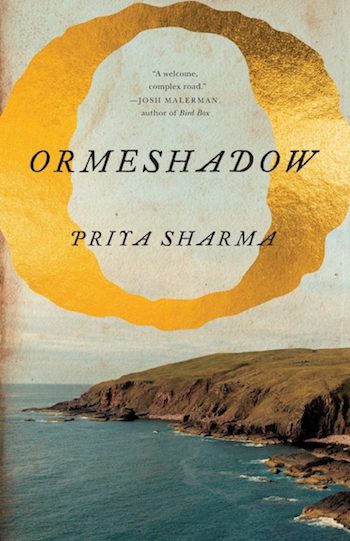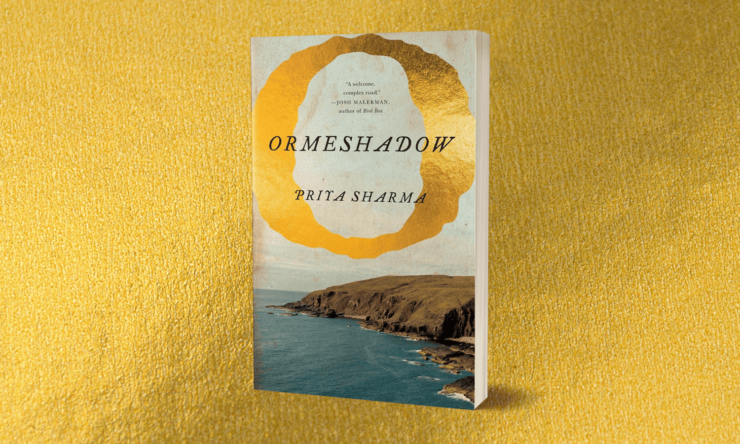A legend in the village of Ormeshadow tells of an orme (Norse for dragon) that fought in a battle against her own kind and fell fast asleep to heal herself. Over centuries, grass grew and homes were built, her body was hidden and her story all but forgotten. Gideon Belman arrives in Ormeshadow at seven years old, carried to his father’s childhood home for reasons he doesn’t yet understand. Slowly, his father reveals to him the story of the orme, and Gideon’s own ancestral ties to her. Faced with the banal cruelty of his new life on the farm, Gideon relies on the orme and confides in her, waiting for the day she’ll finally awake.
Priya Sharma’s new novella Ormeshadow is brooding and subtle, its stark realism set against the lure and power of legend. What might be too heavy in a longer novel is the perfect length here, a window into a life and a sketch of a possibility. It is the perfect autumnal read—moody, atmospheric, and readily paired with a cup of tea and a warm sweater.
The story of Ormeshadow follows Gideon through a life defined by his family and dictated by his Uncle Thomas. It is a rural family drama, rife with casual violence and unspoken grudges. As he comes of age, Gideon struggles to make meaning out of the clues his father has given him about the orme, but above all struggles to survive in a home held together only by tradition. With so little love to hold him to a land he is meant to protect, it’s no wonder that Gideon dreams of escape—he simply can’t seem to decide whether he wants to escape further into the orme, or to leave it altogether.
The subtlety and banality of much of Ormeshadow’s plot makes it that much more gutting and relatable. It is a gendered drama as well as a generational one, and though Uncle Thomas is certainly cast as the villain, the question of right and wrong is more often than not thrown to the wind. The novella begins with a scene in which Gideon’s parents argue over the meaning and the meanness of public execution, and that sets the stage for much of the rest of the story’s events. The climax and resolution are similarly ambiguous and subtle—blink and you’ll miss them. For some, this lack of fully-explained ending might be unsatisfying. I was thrown off by it, but in a way that made me flip to the front and re-read the first chapter. I ultimately found the ending more interesting than moving.
Buy the Book


Ormeshadow
Sharma cites Thomas Hardy as an inspiration for Ormeshadow, and that lineage comes through loud in clear in the story’s tone and familial themes. However, the novella also reminds me distinctively of Ursula K. Le Guin’s Orsinia, both in Sharma’s quiet, graceful styling, and in the way that she shapes a story that feels more like a historical novel than historical fiction. Though one can assume the events of the novella take place in the 18th or 19th centuries, Sharma never explicitly lays out the time period in which her characters move. I consider this a strength: if the story had been set in a city—as Gideon so yearns for—it’s likely that we’d be able to determine the date much more easily. This lack of fixation in time also unsettles the reader, taking them to conceptual, almost mythic proportions despite the novella’s realistic prose and circumstances. The legend of the orme becomes almost a myth inside of a myth.
I am still trying to parse what Sharma is saying in Ormeshadow about our ability to change, our ability to move beyond our birthright, and the connection between the story of the orme and the binding strictures of society and expectation. Despite its seeming simplicity, Ormeshadow is a rich and deftly-told story. Sharma’s perspective is a unique one, on a story that feels familiar. Classic lit readers, as well as fantasy fans—and especially those for whom these categories overlap—should not miss it.
Ormeshadow is available from Tor.com Publishing.
Em Nordling reads, writes, and manages research in Louisville, KY.











Big fan of her work in All the Fabulous Beasts to the point that I pre-ordered Ormeshadow as soon as it was available. I’m so excited to be into a current writer of such quality and be able to await eagerly each new release!